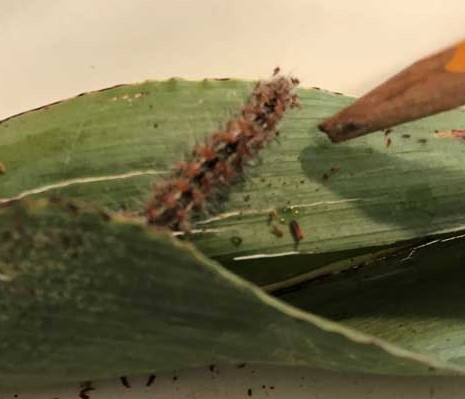Sorghum pests – cattail caterpillars, sugarcane aphids, and headworms
Cattail caterpillars are still abundant throughout north central Kansas causing considerable leaf feeding (Figure 1). Sugarcane aphids are still migrating into Kansas. However, up to now, only small colonies and sporadic infestations have been reported. Every report to date also has reported good numbers of beneficials and seemingly reducing the colonies that do get established. These aphids will probably continue to migrate into the state for some time yet but, hopefully, the beneficials will keep them under control.
Sorghum “headworm” populations are really becoming active. If fields are treated with a conventional insecticide, it will probably kill the headworms, any sugarcane aphids that may come into contact with a treated surface, and most, if not all of the beneficials. Yes, the conventional insecticides used for “headworms” will kill the sugarcane aphids. However, there are some problems with this. First, many of the aphid colonies will be on the undersides of the leaves and many of these leaves will be in the middle region of the plant, somewhat sheltered by higher leaves. Second, these insecticides are contact insecticides, thus, they need to contact the insect to kill it. However, all the beneficials will be very active searching for aphids, thus they have a high probability of coming into contact with, and being killed by, the insecticide. Third, the aphids reproduce parthenogenically thus these populations will increase quite rapidly if there are no beneficials hindering them. So, they will re-colonize much quicker than the beneficials and thus start stressing the plants. However, “headworms” cause 5% loss/worm/head and they feed on the marketable product, thus if they get to the treatment threshold something needs to be done.

Figure 1. Cattail caterpillar.
Now, there is a product available that uses a virus that is relative specific for corn earworms (Heligen) or fall army worms (Fawligen). If you are not sure which species is present in your field, you can mix these two products together. These two products could be an alternative to the conventional synthetic organic insecticides and thus, spare the beneficials to help control sugarcane aphids if they do start to migrate into Kansas in large numbers.
These products do need to be treated a little differently than the more common insecticides. Timing is very important in any management program but even more so with these products then the regular insecticides. These virus compounds take a few days to actually work on the pest versus the common insecticides which kill on contact. Thus, the Heligen or Fawligen compounds need to be applied as soon as the first (Figure 2). hopefully, very small worms are detected to give it a chance to work before the worms cause too much damage. This then highlights one of the problems with these products, i.e., detecting the very small larvae in your bucket (see Figure 2) because they blend in very well with all the pollen, florets, etc. that shake loose.
Figure 2. Example of 3-day old larvae (smaller ones) and 6-day old larvae (larger one).
Also, these products are more sensitive to sunlight which can deactivate the virus within 24 hours after application. Virus containers that are sealed should not be exposed to direct sunlight for more than 2 hours, or in temperatures over 95 degrees F. Product should be mixed in water with a pH of ≤ 8.0, and enough carrier used to adequately spread the product over the entire target. If you decide to try these products, it is best to leave an untreated check strip – which you should do with any product.
Soybean update – soybean aphids
Soybean aphids continue to migrate into the state and with the predicted cooler temperatures may be able to successfully colonize. Thus, monitoring should continue until /or if hotter temperatures return.